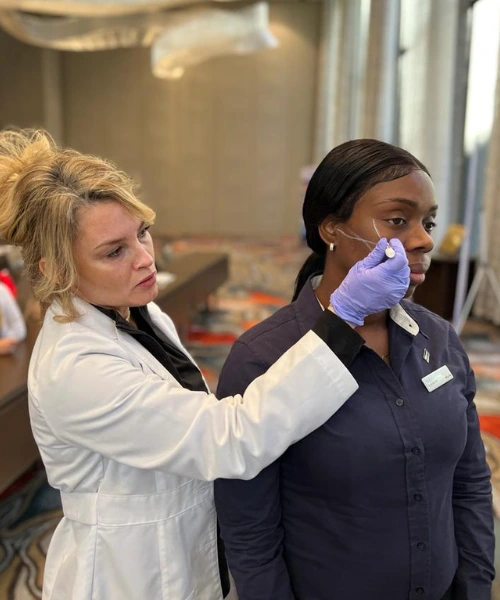Mitigating Botox Complications
By Dr. Stephen Cosentino
PRESIDENT OF EMPIRE MEDICAL TRAINING
Tips & Strategies for Medical Professionals
It’s no secret that botox injections are one of the most sought-after treatments in the medical aesthetics industry. After all, these injections are relatively simple to administer, can be performed in just a few minutes, and offer rapid results for clients.
That’s the good news.
The bad news?
Without adequate botox training and effective administration strategies, even highly skilled professionals can overlook potential botox complications. Empire Medical Training strives to create safer practices in the medical aesthetics space with industry-leading insights and strategies designed to eliminate risks and enhance client satisfaction.
With that in mind, let’s take a look at the most common side effects of botox and how medical professionals can mitigate these complications and ensure safe, effective results for their patients.
What Are Botox Side Effects?
Although botox injections are widely regarded as a low-risk treatment for wrinkles, fine lines, and other common aesthetic concerns, they still pose some potential side effects for patients.
According to the American Society of Plastic Surgeons, the most common botox complications include:
- Bruising or swelling around the injection site
- Temporary pain or discomfort in the treated area
- Mild flu-like symptoms
- Headaches
- Nausea
- Redness
While these side effects are perfectly normal, there are some more extreme complications that professionals should be aware of.
For example, rubbing or massaging the treated area immediately after receiving injections can cause the botox to migrate to other areas of the face. If this happens, the patient may experience more severe reactions, such as:
- Facial weakness
- Skin drooping
- Inability to produce facial expressions
Botox has also been known to produce allergic reactions in some patients, which is why having a strategic plan for mitigating these concerns is crucial for medical professionals.
How Can Professionals Mitigate Botox Complications?
At Empire Medical Training, we believe that great results start with a dynamic action plan. Here’s how our team recommends tackling concerns surrounding botox complications and, most importantly, providing world-class care for your patients.
Undergo Proper Botox Training
First and foremost, having proper botox training is crucial. Today, there are countless botox training programs on the market for professionals looking to get into the medical aesthetics industry.
However, not all training programs are created equal.
Before you register for a botox course or training program, there are a few questions you should ask yourself.
Was it created by medical professionals?
No oneshould be teaching the art of botox injections other than skilled physicians. For example, ourbest-selling botox training programwas founded by an elite team of medical professionals, including aesthetic experts, doctors, nurses, and dentists, with decades of combined expertise in treating patients.
Does it have a track record of success?
Any high-quality botox course should have a proven track record for you to review. Since 1998, our program has helped more than 175,000 professionals receive their certification and provide exceptional service to their patients.
Does the course include foundational facial anatomy?
Before taking your course, you should be able to review its curriculum and determine whether the material is sufficient for your training. More specifically, you should only purchase botox training programs that cover foundational facial anatomy, which is critical when administering injections to patients.
These are just a few of the major indicators you should look for when choosing the right botox training program for your needs.
Utilize Continued Learning Programs
Botox training shouldn’t end once you’ve been certified. Instead, you should seek out continued learning programs that help you enhance your skills and stay informed about current trends and techniques in the medical aesthetics industry.
Empire Medical Training offers a range of workshops andmembershipsdesigned to help our students stay on the cutting edge of aesthetics artistry. By continuing to educate yourself, you can provide unmatched service for every patient you treat.
Review The Patient’s History
Despite its popularity, botox injections are not suitable for everyone. That’s why reviewing and documenting your patient’s history is a critical first step in the treatment process. Some conditions that may result in severe botox complications include:
- Pregnancy or breastfeeding
- Asthma or other respiratory conditions
- Neuromuscular disorders like ALS, Lambert-Eaton Syndrome, and myasthenia gravis
- Known botox allergies
Besides their medical history, patients are also more susceptible to botox side effects if they’re currently experiencing other infections or inflammation in the desired treatment area. In this case, you should postpone treatment until the issues can be properly resolved.
Prepare The Injection Site
Once you’re confident your patient is ready for treatment, follow rigorous protocols for preparing the injection site. This includes treating the area with a mild cleaning solution that sanitizes the skin without leaving any harshness or irritations behind.
Some patients may also request a mild numbing treatment to avoid discomfort during their session. Most physicians recommend a topical anesthetic treatment, but you should also consult the patient’s history to ensure they don’t have allergies that could result in a bad reaction.
Provide Patient Instructions
Unfortunately, most botox complications aren't caused by your treatment methods. Instead, they're caused by a lack of proper pre and post-care instructions. Before treating your patients, ensure they have reviewed the requirements for preparing for treatment and caring for the injection site afterward.
Before treatment, patients should avoid:
- Drinking alcohol for at least 24 hours
- Taking blood thinners
- Rigorous exercise
- Other facial treatments
- Wearing makeup or oily products
After they’ve been treated, patients should be advised to avoid:
- Touching or rubbing the injection site
- Saunas or hot tubs
- Direct sunlight exposure
- Consuming alcohol or caffeine for 24 hours
- Taking blood thinners
- Lying down for prolonged periods of time
- Rigorous exercise
Communicating with your patients is vital throughout the treatment process. We recommend creating a strategic communication plan before, during, and after treatment to ensure your clients get the results they deserve.
Where To Find Advanced Botox Training Programs
Empire Medical Training has been providing elite botox training and other specialized medical aesthetic certifications for more than 20 years. Our programs offer in-person, online, and hybrid options tailored to your needs. Connect with our team today to take your botox training to the next level.


